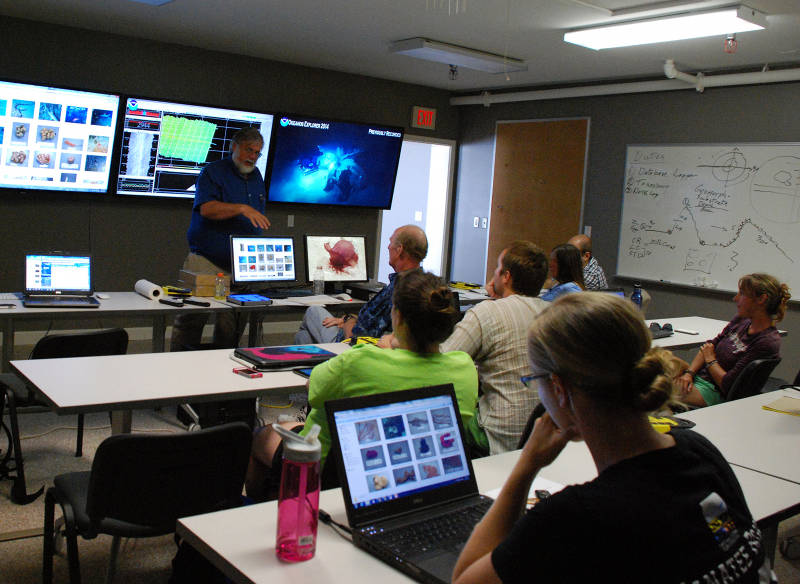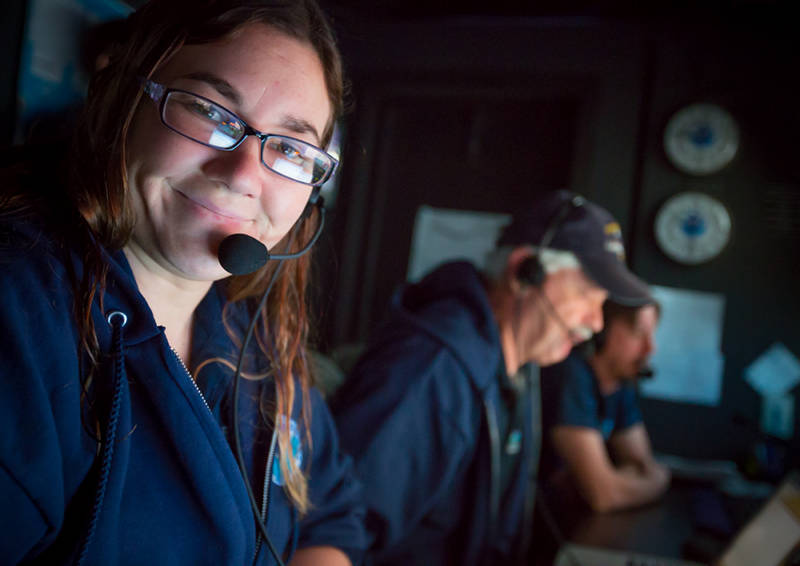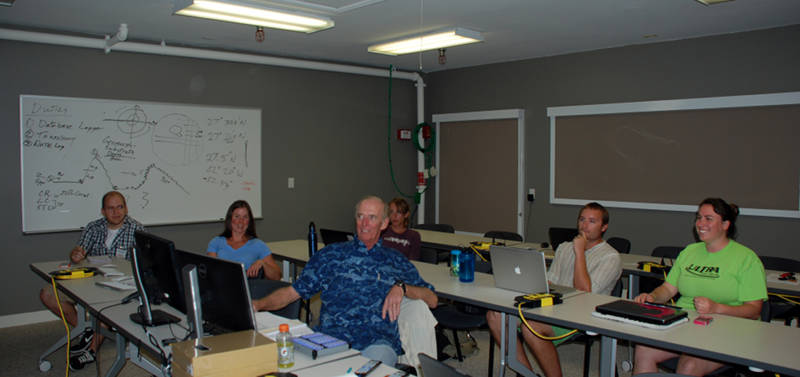
By Shirley Pomponi, Ph.D., Research Professor - Florida Atlantic University Harbor Branch, and CIOERT Executive Director
April 26, 2014

While Okeanos transits to the West Florida Escarpment, Dennis Hanisak runs through what operations will be like in the Harbor Branch ECC during the last five dives of the 2014 Gulf of Mexico Expedition. Image courtesy of the NOAA Office of Ocean Exploration and Research, Exploration of the Gulf of Mexico 2014. Download larger version (jpg, 4.2 MB).
Welcome to the new Ocean Exploration Command Center (ECC) at the Cooperative Institute for Ocean Exploration, Research, and Technology (CIOERT), Harbor Branch Oceanographic Institute (HBOI) at Florida Atlantic University!

Onboard science team co-lead for Leg 3 of the 2014 Gulf of Mexico Expedition, Stephanie Farrington is a biological research specialist with Harbor Branch Oceanographic Institution at Florida Atlantic University and a key member of the CIOERT team. Along with others in the ocean science community, her team will join her from CIOERT’s new ECC at HBOI for dives on the West Florida Escarpment from April 26-30, helping to guide the operation from shore. Image courtesy of the NOAA Office of Ocean Exploration and Research, Exploration of the Gulf of Mexico 2014. Download larger version (jpg, 425 KB).
The CIOERT exploration and research team is excited about the opportunity to participate in the Okeanos Explorer’s missions of discovery—especially during the final “leg” of the mission in the eastern Gulf of Mexico. This area is a “hotspot” for CIOERT’s exploration and research activities.
For the next five days of exploration, we are targeting areas off the west Florida Continental Shelf. From previous submersible dives, we have identified this region to be a “hotspot of biodiversity,” hosting numerous mounds, 10-20 meters tall, some of which are capped with thickets of live Lophelia coral. A single coral mound may be hundreds of thousands of years old. Besides their ecological importance, these deep-water coral habitats are important to marine fisheries, including the golden crab (Chaceon fenneri).
The sites we are targeting for exploration were selected from analysis of multibeam sonar imagery. We plan to explore for deep-water corals, to photo-document their abundance and condition, and to characterize the overall faunal composition. The data and information we collect will be made readily available to fisheries management agencies.
CIOERT scientists have been exploring, discovering, mapping, characterizing, and studying deep coral reefs for decades. In fact, CIOERT-HBOI scientist John Reed’s work on the Oculina reefs off the coast of Florida resulted in the Oculina Habitat Area of Particular Concern – the first marine protected area in the world protecting deepwater coral reefs.

John Reed leads a group of students through a pre-dive briefing, introducing them to the scientific priorities and the potential species that we may encounter during the upcoming dives. Image courtesy of the NOAA Office of Ocean Exploration and Research, Exploration of the Gulf of Mexico 2014. Download larger version (jpg, 3.1 MB).
On April 24, 2014, John presented proposals to the Gulf of Mexico Fishery Management Council for expansion of the Pulley Ridge Habitat Area of Particular Concern, deep-water Lophelia coral sites on the west Florida shelf, and expansion of the Florida Keys National Marine Sanctuary, based on research we’ve done in these areas. CIOERT scientists work closely with another cooperative institute—Cooperative Institute for Marine and Atmospheric Studies (CIMAS)—at the University of Miami, as well as colleagues from NOAA Fisheries, Sanctuaries, National Ocean Service, Office of Oceanic and Atmospheric Research, Office of Ocean Exploration and Research, and the National Institute for Undersea Science and Technology.
Up until about three years ago, most of our deep and mesophotic coral reef ecosystem exploration and undersea research was conducted using HBOI’s Johnson-Sea-Link submersibles. More recently, we’ve been using remotely operated vehicles (ROV)(University of Connecticut Kraken II and the University of North Carolina-Wilmington Super Phantom), as well as autonomous underwater vehicles and gliders to conduct mapping and surveys.
Later this summer, in collaboration with CIMAS (and using the National Marine Sanctuaries Foundation’s new ROV, the Mohawk, operated by CIOERT partner, University of North Carolina-Wilmington), we will continue our exploration, habitat characterization, and research on the West Florida shelf. The next few days of exploration with the Okeanos Explorer and the Deep Discoverer ROV will provide important information to guide our more detailed ROV work on our CIOERT cruises this summer and beyond.